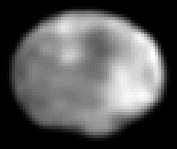4 Vesta
|
|
| Discovery A (http://cfa-www.harvard.edu/iau/lists/NumberedMPs.html) | |
|---|---|
| Discoverer | Heinrich Wilhelm Olbers |
| Discovery date | March 29, 1807 |
| Alternate designations | B (http://cfa-www.harvard.edu/iau/MPDes.html) |
| Category | Main belt (Vesta family) |
| Orbital elements C (http://asteroid.lowell.edu/) Epoch July 14, 2004 (JD 2453200.5) | |
| Eccentricity (e) | 0.089 |
| Semi-major axis (a) | 353.323 Gm (2.362 AU) |
| Perihelion (q) | 321.956 Gm (2.152 AU) |
| Aphelion (Q) | 384.689 Gm (2.571 AU) |
| Orbital period (P) | 1325.768 d (3.63 a) |
| Mean orbital speed | 19.38 km/s |
| Inclination (i) | 7.133° |
| Longitude of the ascending node (Ω) | 103.936° |
| Argument of perihelion (ω) | 150.271° |
| Mean anomaly (M) | 69.905° |
| Physical characteristics | |
| Dimensions | 468.3 km |
| Mass | 2.701×1020 kg |
| Density | 5.0 g/cm³ |
| Surface gravity | 0.30 m/s² |
| Escape velocity | 0.39 km/s |
| Rotation period | 0.2226 d |
| Spectral class | V-type asteroid |
| Absolute magnitude | 3.20 |
| Albedo | 0.423 |
| Mean surface temperature | ~162 K |
4 Vesta (ves'-ta) is the third-largest asteroid in the Main belt, between 530 and 468 km in diameter. This and the unusually bright surface make Vesta the brightest asteroid. It is the only asteroid sometimes visible to the naked eye.
| Contents [hide] |
Discovery
Vesta was discovered by the German astronomer Heinrich Wilhelm Olbers on March 29, 1807. He allowed the prominent mathematician Carl Friedrich Gauss to name the asteroid after the Roman virgin goddess of home and hearth, Vesta.
After the discovery of Vesta in 1807, no other asteroids were discovered for 38 years; the next was 5 Astraea.
Physical characteristics
In the earliest times of the Solar system, Vesta was hot enough for its interior to melt. This resulted in differentiation of the asteroid. It is likely to have a layered structure: a metallic iron-nickel core and an overlying olivine mantle. The surface is basaltic rock from ancient lava flows, obviously some kind of short-lived volcanic activity was present. This makes Vesta unlike any other asteroid and in a sense it is more like the terrestrial planets, which underwent similar geological processes.
However, it was not the only one of its kind; originally, there may have been dozens of similar large planetesimals, but all the other bodies were shattered into families of smaller asteroids during the chaotic early times. Metallic iron-nickel asteroids are thought to originate from the cores of such bodies, with stony asteroids deriving from their crusts and mantles.
Not even Vesta has survived intact. In 1996 the Hubble Space Telescope (see image below) detected a huge crater on Vesta, 430 kilometres across and perhaps a billion years old. It is thought that this crater may be the source of the small V-type asteroids (or Vestoids) observed today.
In 2001 one such asteroid, 1929 Kollaa, was not only determined to be a piece from Vesta, but also the exact location of its formation was traced to deep in the crust.
The Yarkovsky effect, along with perturbing planets and asteroids, causes scattering among the Vesta family. Some family members, such as 9969 Braille, have become Near-Earth asteroids. Smaller fragments have even rained down as meteorites; Vesta is thought to be the source of the HED meteorites.
Our knowledge about Vesta is expected to increase tremendously when the Dawn probe enters orbit around the asteroid for nine months in 2010-2011.
1_Ceres,_2_Pallas,_4_Vesta_and_10_Hygiea.png
References
- K. Keil, Geological History of Asteroid 4 Vesta: The Smallest Terrestrial Planet in Asteroids III, William Bottke, Alberto Cellino, Paolo Paolicchi, und Richard P. Binzel, (Editors), Univ. of Arizona Press (2002), ISBN 0816522812
- IRAS Minor Planet Survey (1994) (http://dorothy.as.arizona.edu/DSN/IRAS/index_iras.html)
- E. V. Pitjeva, Estimations of Masses of the Largest Asteroids and the Main Asteroid Belt From Ranging to Planets, Mars Orbiters And Landers (2004) (http://www.cosis.net/abstracts/COSPAR04/02014/COSPAR04-A-02014.pdf)
External links
- Views of the Solar System: Vesta (http://www.solarviews.com/eng/vesta.htm)
- HubbleSite (http://hubblesite.org/newscenter/newsdesk/archive/releases/1995/40/): Hubble Maps the Asteroid Vesta
- HubbleSite (http://hubblesite.org/newscenter/newsdesk/archive/releases/1997/27/): Hubble Reveals Huge Crater on the Surface of the Asteroid Vesta
- Adaptive optics views of Vesta from Keck Observatory (http://www2.keck.hawaii.edu/ao/vesta-ao.html)
| The minor planets |
| Vulcanoids | Main belt | Groups and families | Near-Earth objects | Jupiter Trojans |
| Centaurs | Trans-Neptunians | Damocloids | Comets | Kuiper belt | Oort cloud |
| (For other objects and regions, see: Binary asteroids, Asteroid moons and the Solar system) |
| (For a complete listing, see: List of asteroids. For pronunciation, see: Pronunciation of asteroid names.) |
de:Vesta (Asteroid) es:(4) Vesta fr:4 Vesta gl:Vesta (asteroide) it:4 Vesta nl:Vesta (planetoïde) ja:ベスタ (小惑星) pl:Westa (planetoida) pt:4 Vesta

